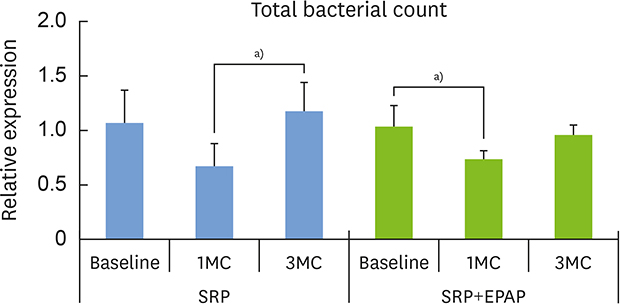1. Matuliene G, Pjetursson BE, Salvi GE, Schmidlin K, Brägger U, Zwahlen M, et al. Influence of residual pockets on progression of periodontitis and tooth loss: results after 11 years of maintenance. J Clin Periodontol. 2008; 35:685–695.

2. Rosling B, Serino G, Hellström MK, Socransky SS, Lindhe J. Longitudinal periodontal tissue alterations during supportive therapy. Findings from subjects with normal and high susceptibility to periodontal disease. J Clin Periodontol. 2001; 28:241–249.
3. Wilson TG Jr. Supportive periodontal treatment introduction--definition, extent of need, therapeutic objectives, frequency and efficacy. Periodontol 2000. 1996; 12:11–15.

4. Lindhe J, Westfelt E, Nyman S, Socransky SS, Haffajee AD. Long-term effect of surgical/non-surgical treatment of periodontal disease. J Clin Periodontol. 1984; 11:448–458.

5. Zappa U, Smith B, Simona C, Graf H, Case D, Kim W. Root substance removal by scaling and root planing. J Periodontol. 1991; 62:750–754.

6. Vastardis S, Yukna RA, Rice DA, Mercante D. Root surface removal and resultant surface texture with diamond-coated ultrasonic inserts: an
in vitro and SEM study. J Clin Periodontol. 2005; 32:467–473.

7. Axtelius B, Söderfeldt B, Edwardsson S, Attström R. Therapy-resistant periodontitis (II). Compliance and general and dental health experiences. J Clin Periodontol. 1997; 24:646–653.

8. Croft LK, Nunn ME, Crawford LC, Holbrook TE, McGuire MK, Kerger MM, et al. Patient preference for ultrasonic or hand instruments in periodontal maintenance. Int J Periodontics Restorative Dent. 2003; 23:567–573.
9. Rabbani GM, Ash MM Jr, Caffesse RG. The effectiveness of subgingival scaling and root planing in calculus removal. J Periodontol. 1981; 52:119–123.

10. Eaton KA, Kieser JB, Davies RM. The removal of root surface deposits. J Clin Periodontol. 1985; 12:141–152.

11. Fleischer HC, Mellonig JT, Brayer WK, Gray JL, Barnett JD. Scaling and root planing efficacy in multirooted teeth. J Periodontol. 1989; 60:402–409.

12. Greenstein G. Periodontal response to mechanical non-surgical therapy: a review. J Periodontol. 1992; 63:118–130.

13. Moëne R, Décaillet F, Andersen E, Mombelli A. Subgingival plaque removal using a new air-polishing device. J Periodontol. 2010; 81:79–88.

14. Wennström JL, Dahlén G, Ramberg P. Subgingival debridement of periodontal pockets by air polishing in comparison with ultrasonic instrumentation during maintenance therapy. J Clin Periodontol. 2011; 38:820–827.

15. Kontturi-Narhi V, Markkanen S, Markkanen H. Effects of air polishing on dental plaque removal and hard tissues as evaluated by scanning electron microscopy. J Periodontol. 1990; 61:334–338.
16. Lubow RM, Cooley RL. Effect of air-powder abrasive instrument on restorative materials. J Prosthet Dent. 1986; 55:462–465.

17. Petersilka GJ, Bell M, Häberlein I, Mehl A, Hickel R, Flemmig TF. In vitro evaluation of novel low abrasive air polishing powders. J Clin Periodontol. 2003; 30:9–13.
18. Petersilka GJ, Steinmann D, Häberlein I, Heinecke A, Flemmig TF. Subgingival plaque removal in buccal and lingual sites using a novel low abrasive air-polishing powder. J Clin Periodontol. 2003; 30:328–333.

19. Flemmig TF, Arushanov D, Daubert D, Rothen M, Mueller G, Leroux BG. Randomized controlled trial assessing efficacy and safety of glycine powder air polishing in moderate-to-deep periodontal pockets. J Periodontol. 2012; 83:444–452.

20. Wennström JL, Dahlén G, Ramberg P. Subgingival debridement of periodontal pockets by air polishing in comparison with ultrasonic instrumentation during maintenance therapy. J Clin Periodontol. 2011; 38:820–827.

21. Hägi TT, Hofmänner P, Salvi GE, Ramseier CA, Sculean A. Clinical outcomes following subgingival application of a novel erythritol powder by means of air polishing in supportive periodontal therapy: a randomized, controlled clinical study. Quintessence Int. 2013; 44:753–761.
22. Munro IC, Berndt WO, Borzelleca JF, Flamm G, Lynch BS, Kennepohl E, et al. Erythritol: an interpretive summary of biochemical, metabolic, toxicological and clinical data. Food Chem Toxicol. 1998; 36:1139–1174.

23. Hashino E, Kuboniwa M, Alghamdi SA, Yamaguchi M, Yamamoto R, Cho H, et al. Erythritol alters microstructure and metabolomic profiles of biofilm composed of
Streptococcus gordonii and
Porphyromonas gingivalis
. Mol Oral Microbiol. 2013; 28:435–451.

24. Hägi TT, Hofmänner P, Eick S, Donnet M, Salvi GE, Sculean A, et al. The effects of erythritol air-polishing powder on microbiologic and clinical outcomes during supportive periodontal therapy: six-month results of a randomized controlled clinical trial. Quintessence Int. 2015; 46:31–41.
25. Pfaffl MW. A new mathematical model for relative quantification in real-time RT-PCR. Nucleic Acids Res. 2001; 29:e45.

26. Hajishengallis G.
Porphyromonas gingivalis-host interactions: open war or intelligent guerilla tactics? Microbes Infect. 2009; 11:637–645.

27. Hajishengallis G, Darveau RP, Curtis MA. The keystone-pathogen hypothesis. Nat Rev Microbiol. 2012; 10:717–725.

28. Evans RT, Klausen B, Sojar HT, Bedi GS, Sfintescu C, Ramamurthy NS, et al. Immunization with
Porphyromonas (Bacteroides) gingivalis fimbriae protects against periodontal destruction. Infect Immun. 1992; 60:2926–2935.

29. Persson GR, Engel D, Whitney C, Darveau R, Weinberg A, Brunsvold M, et al. Immunization against
Porphyromonas gingivalis inhibits progression of experimental periodontitis in nonhuman primates. Infect Immun. 1994; 62:1026–1031.

30. Petersilka G, Panitz W, Weresch R, Eichinger M, Kem U. Air emphysema in periodontal therapy: a case series and critical literature overview. Parodontol. 2010; 21:165–175.









 PDF
PDF ePub
ePub Citation
Citation Print
Print




 XML Download
XML Download